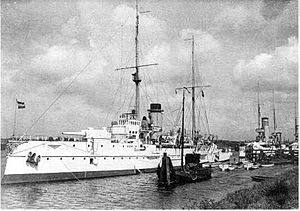Dutch–Venezuela War
| Dutch–Venezuelan crisis | |||||||
|---|---|---|---|---|---|---|---|
 The Dutch warship Jacob van Heemskerck |
|||||||
|
|||||||
| Belligerents | |||||||
|
|
|
||||||
| Commanders and leaders | |||||||
| Cipriano Castro | |||||||
| Strength | |||||||
| 1 pantserschip (coastal defence ship) 2 protected cruisers |
|||||||
In 1908 a dispute broke out between the Netherlands and the president of Venezuela Cipriano Castro on the grounds of the harbouring of Jewish refugees from Coro in Curaçao.
Venezuela expelled the Dutch ambassador, prompting a Dutch dispatch of three warships - a pantserschip (coastal defence ship), the Jacob van Heemskerk, and two protected cruisers, the Gelderland and the Friesland. The Dutch warships had orders to intercept every ship that was sailing under the Venezuelan flag. On 12 December, the Gelderland captured the Venezuelan coast guard ship Alix off Puerto Cabello. She and another ship the 23 de Mayo were interned in harbor of Willemstad. With their overwhelming naval superiority, the Dutch enforced a blockade on Venezuela's ports. A few days later, General Castro left for Berlin, nominally for a surgical operation. In his absence, an uprising in Caracas overthrew his regime. This effectively ended the war with the Netherlands.
...
Wikipedia
